---
title: Reproducibility in functional package management
date: 2025-4-25
date-format: long
lightbox: true
logo: telecom.png
margin-top: "0px"
author:
- name:
given: Julien
family: Malka
url: https://luj.fr
email: julien.malka@telecom-paris.fr
orcid: 0009-0008-9845-6300
roles:
- conceptualization
- investigation
- writing – original draft
affiliations:
- id: telecom
name: Télécom Paris, Institut Polytechnique de Paris
fig-align: center
code-overflow: wrap
code-line-numbers: false
css: styles.css
format:
metropolis-beamer-revealjs:
theme: slide.scss
toc: false
toc-title: Plan
toc-depth: 2
slide-level: 2
slide-number: true
---
## Research topics
**Main topics:** Cybersecurity & Software engineering
*How can one trust the software installed on one’s system is not malicious?*
- What if we make the assumption that the software is **open source**?
**Research question**: How to increase trust in the Open Source Software Supply Chain with *functional package managers* and *reproducible builds*?
## Functional package managers {auto-animate="true"}
New software deployment model (from which **Nix** has been the first example).
```nix
{ stdenv, lib, fetchFromGitHub }:
```
## Functional package managers {auto-animate="true"}
New software deployment model (from which **Nix** has been the first example).
```nix
{ stdenv, lib, fetchFromGitHub }:
stdenv.mkDerivation rec {
version = "1.3.7";
pname = "htpdate";
src = fetchFromGitHub {
owner = "twekkel";
repo = pname;
rev = "v${version}";
sha256 = "sha256-X7r95Uc4oGB0eVum5D7pC4tebZIyyz73g6Q/D0cjuFM=";
};
```
## Functional package managers {auto-animate="true"}
New software deployment model (from which **Nix** has been the first example).
```nix
{ stdenv, lib, fetchFromGitHub }:
stdenv.mkDerivation rec {
version = "1.3.7";
pname = "htpdate";
src = fetchFromGitHub {
owner = "twekkel";
repo = pname;
rev = "v${version}";
sha256 = "sha256-X7r95Uc4oGB0eVum5D7pC4tebZIyyz73g6Q/D0cjuFM=";
};
makeFlags = [
"prefix=$(out)"
];
```
## Functional package managers {auto-animate="true"}
::: {.r-fit-text}
New software deployment model (from which **Nix** has been the first example).
```nix
{ stdenv, lib, fetchFromGitHub }:
stdenv.mkDerivation rec {
version = "1.3.7";
pname = "htpdate";
src = fetchFromGitHub {
owner = "twekkel";
repo = pname;
rev = "v${version}";
sha256 = "sha256-X7r95Uc4oGB0eVum5D7pC4tebZIyyz73g6Q/D0cjuFM=";
};
makeFlags = [
"prefix=$(out)"
];
meta = with lib; {
description = "Utility to fetch time and set the system clock over HTTP";
platforms = platforms.linux;
license = licenses.gpl2Plus;
maintainers = with maintainers; [ julienmalka ];
};
}
```
:::
## Evaluation->Build pipeline
::: {#fig-eval-build}
{.r-stretch}
Eval-build pipeline
:::
## Functional package managers for SSC security
Functional package managers also have interesting properties for software supply chain security (which are of interest for us):
- Builds from source;
- Sandboxed compilation.
## Functional package managers for SSC security
- Installed packages create a static graph structure (a Merkle tree) that can be analysed in order to find known vulnerability in the dependencies.
::: {#fig-eval-build}
{.r-stretch}
Example of a package dependency graph
:::
## The binary distribution problem
- It is not always reasonable to compile all the software a user wants to install on their own machine: creates the necessity of binary caches ;
- **But** binary caches make us lose some of the interesting security properties of functional package managers.
## Reproducible builds {.lol}
{height='4em' fig-align="center"}
A build is **reproducible** if given the same source code, build environment and build instructions, any party can recreate bit-by-bit identical copies of all specified artifacts.
## Why is build reproducibility important?
:::: {.columns}
::: {.column width="40%"}
- Reproducible builds can be useful to improve the **security** of the **binary distribution problem**;
- Instead of having to trust a single third party to provide them the correct binary, they can divide the trust between multiple parties.
:::
::: {.column width="60%"}
::: {#fig-rb}
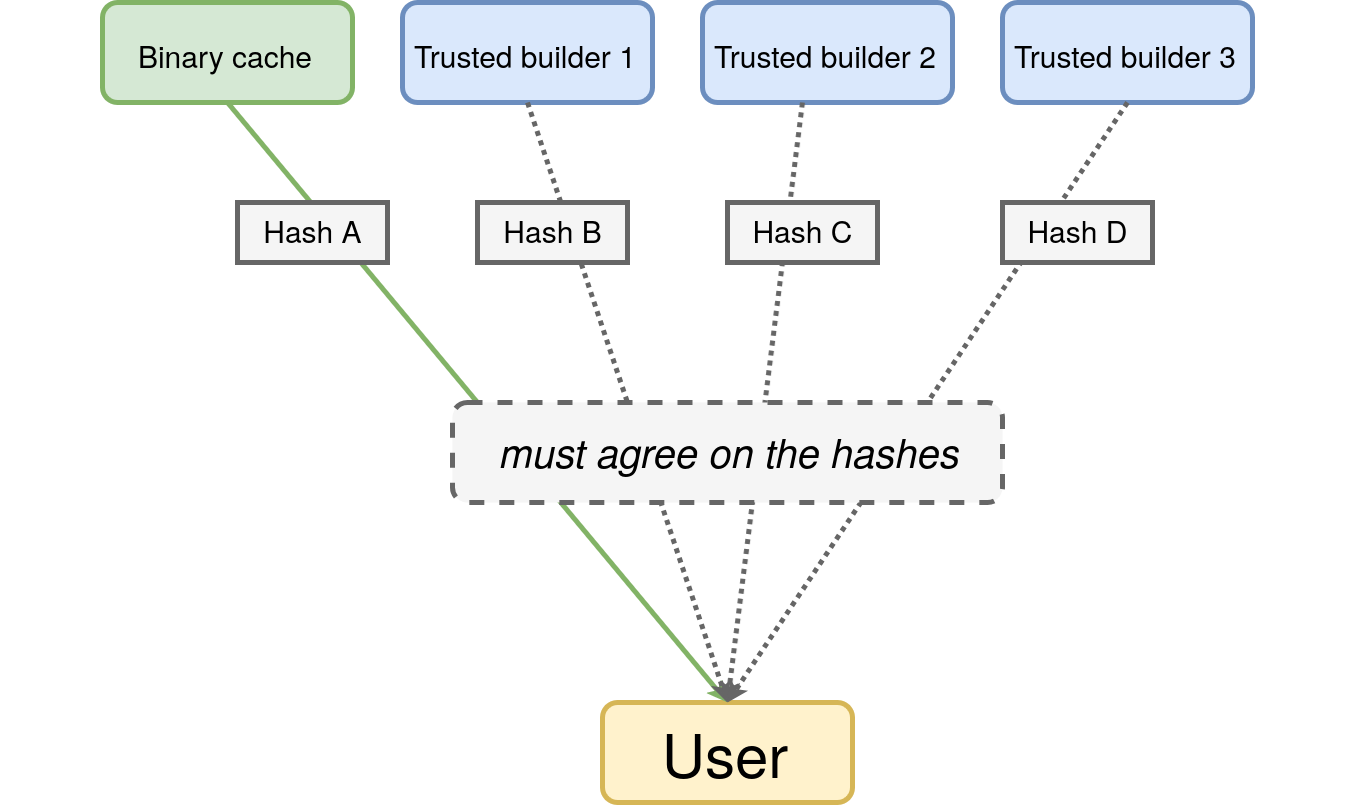{height='13em'}
Leveraging reproducible-builds to increase trust in distributed artifacts.
:::
:::
::::
## Research questions {auto-animate="true"}
**How reproducible is software in the functional package management model?**
- Is Nix evaluation reproducible? Can we reproduce *build environments* of Nix packages?
- Do functional package management enable **bitwise build reproducibility**?
## Reproducibility of build environments {auto-animate="true"}
- Is Nix evaluation reproducible? Can we reproduce *build environments* of Nix packages?
:::: {.columns}
::: {.column width="50%"}
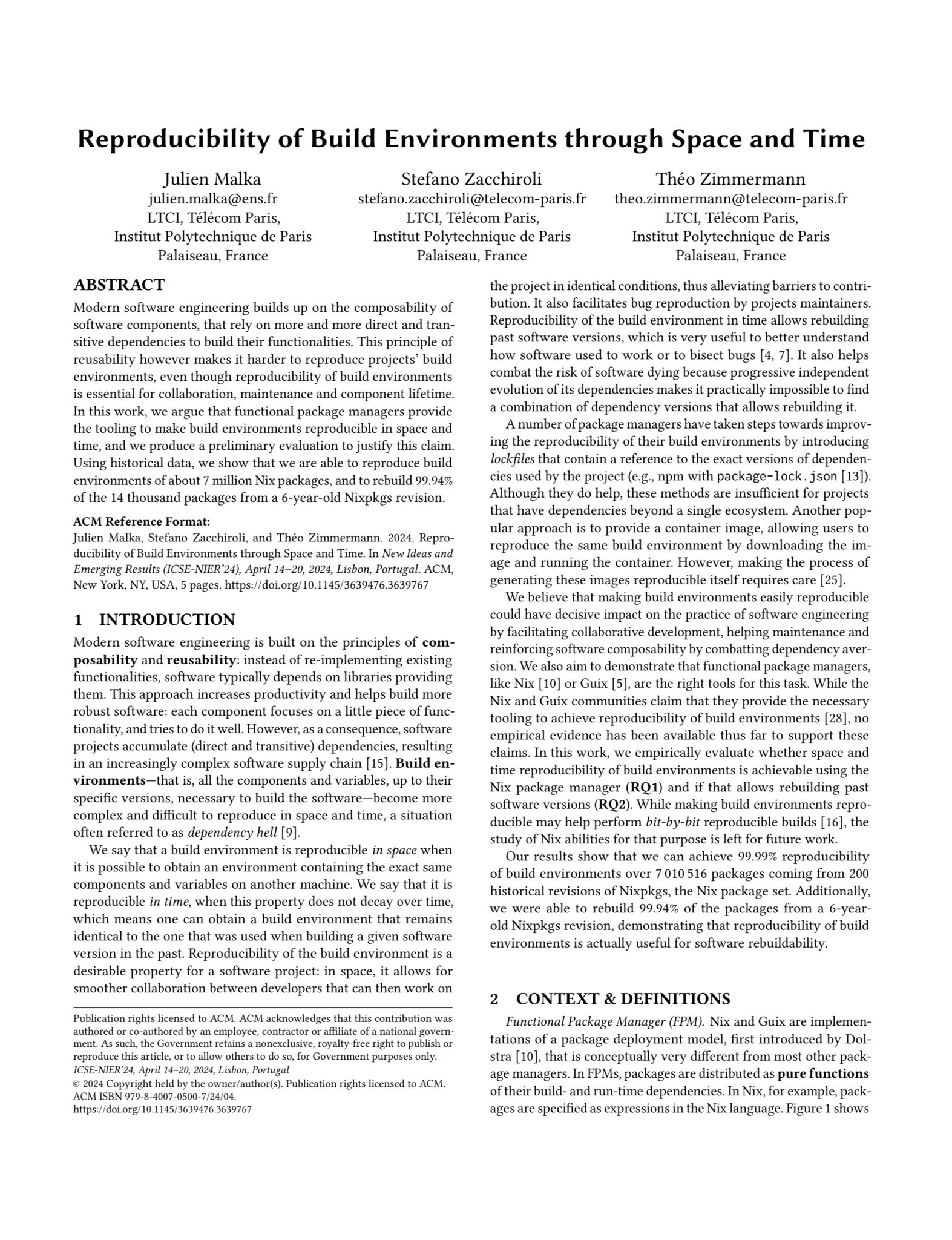{height='14em'}
:::
::: {.column width="50%"}
**"Reproducibility of Build Environments through Space and Time"**, ICSE 2024 (New Ideas and Emerging Results track), *J. Malka, S. Zacchiroli, T. Zimmermann*.
:::
::::
## Reproducibility of build environments
We say that two build environments are identical if they contain the **exact same set of executables, up to their specific versions**.

## Reproducibility in Space
::: {#fig-rb}

Reproducibility of build environments in Space
:::
## Reproducibility in Time
::: {#fig-rb}
{.r-stretch}
Reproducibility of build environments in Time
:::
## Research questions
::: {.incremental}
- **RQ1:** Is space and time reproducibility of build environments achievable with Nix ?
- **RQ2:** Does it allow rebuilding of past software versions ?
:::
## Experimental protocol
::: {.incremental}
1) Sample 200 revisions of the Nix software repository, picked from 2017 to 2023;
2) For each sampled revision, perform the **evaluation** of each package and compare with the historical truth (historical CI results);
3) For the *oldest revision* of our samples, perform the **build** of each package and compare with the historical truth.
:::
## Results {auto-animate="true"}
**RQ1:** *Reproducibility of build environments*
- We were able to **reproduce the build environment of 99.99% of the packages** we tested;
- Discrepancies we found were due to the (unfortunate) use of some of Nix’s impure builtins.
## Results {auto-animate="true"}
**RQ1:** *Reproducibility of build environments*
- We were able to **reproduce the build environment of 99.99% of the packages** we tested;
- Discrepancies we found were due to the (unfortunate) use of some of Nix’s impure builtins.
**RQ2:** *Rebuilding past software versions*
- We were able to **build successfully 14233 out of the 14242 (99.94%) packages that were built successfully by CI in 2017**;
- Discrepancies we found were due to leakages of the Nix build sandbox, that we wish to investigate further.
## Research questions {auto-animate="true"}
**How reproducible is software in the functional package management model?**
- Is Nix evaluation reproducible? Can we reproduce *build environments* of Nix packages?
- Do functional package management enable **bitwise build reproducibility**?
## Build reproducibility {auto-animate="true"}
- Do functional package management enable **bitwise build reproducibility**?
:::: {.columns}
::: {.column width="50%"}
{height='14em'}
:::
::: {.column width="50%"}
**"Does Functional Package Management Enable Reproducible Builds at Scale? Yes."**, MSR 2025, *J. Malka, S. Zacchiroli, T. Zimmermann*.
:::
::::
## Motivations
Reproducible builds are good for software supply chain security, however...
- **Achieving build reproducibility is difficult**: there exist a lot of non- determinisms in compilers that have effects on produced artifacts;
- Uncertainty among reproducibility experts on the feasibility to achieve build reproducibility **at scale** (even though good players like Debian already achieve impressive performance) [^1]
[^1]: M. Fourné, D. Wermke, W. Enck, S. Fahl and Y. Acar, "It’s like flossing your teeth: On the Importance and Challenges of Reproducible Builds for Software Supply Chain Security," 2023 IEEE Symposium on Security and Privacy
## Research questions
::: {.incremental}
- **RQ1:** What is the evolution of bitwise reproducible packages in `nixpkgs` between 2017 and 2023?
- **RQ2:** What are the unreproducible packages?
- **RQ3:** Why are packages unreproducible?
- **RQ4:** How are unreproducibilities fixed? *(Not covered in this talk)*
:::
## Research methodology
::: {#fig-methodology}
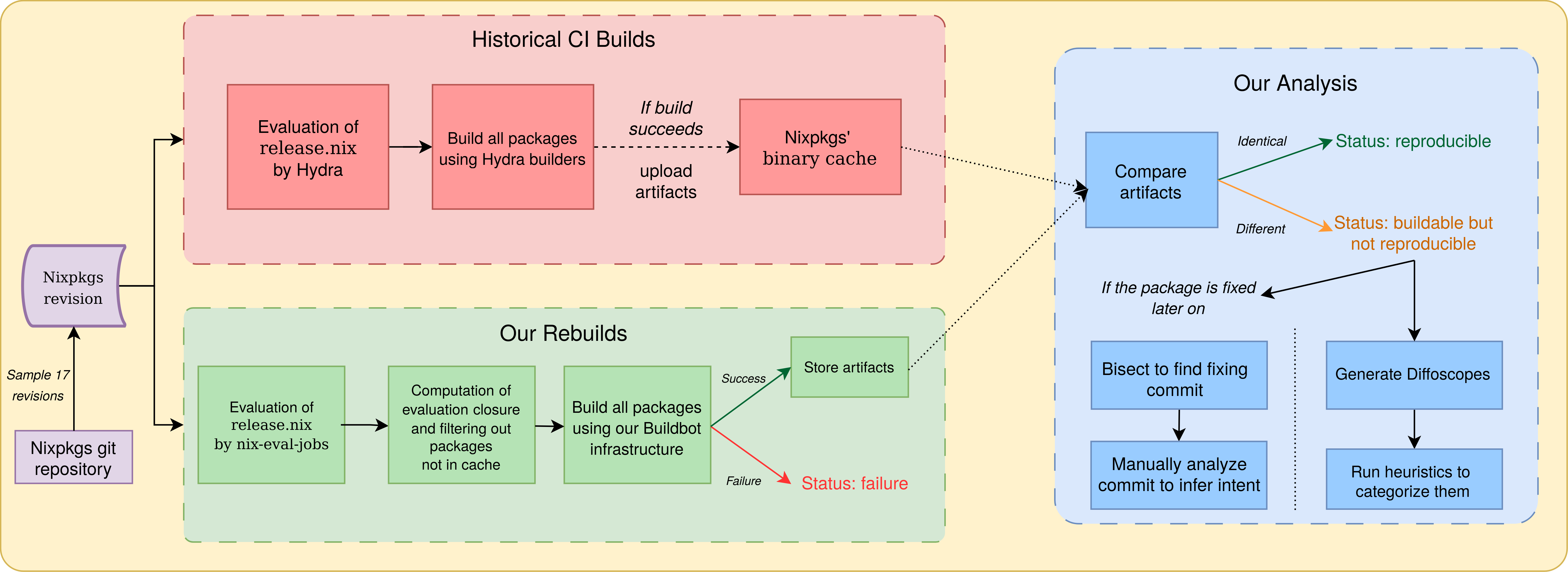{fig-align="center"}
Pipeline summarizing our research methodology.
:::
## A few figures
::::{.columns}
::: {.column width="60%"}
::: {#fig-diffoscope}
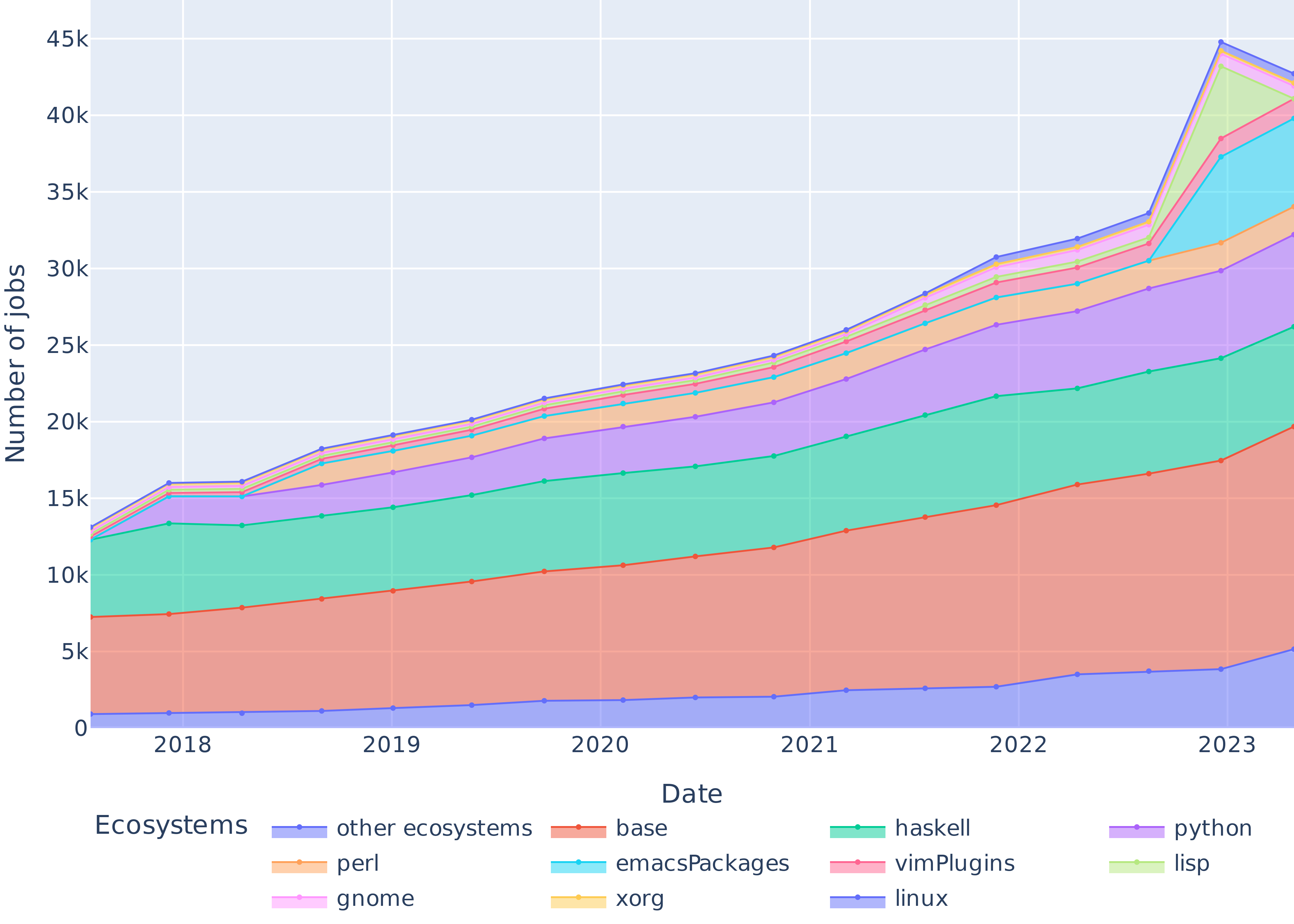
Evolution of the size of the nine most popular software ecosystems in `nixpkgs`.
:::
:::
::: {.column width="40%"}
- 709 816 packages built;
- 14 296 total build hours;
- 548 390 tracked by name and corresponding to 59 103 unique packages associated to a specific software ecossytem .
:::
::::
## RQ1: Evolution of bitwise reproducible packages
::: {#fig-overall}
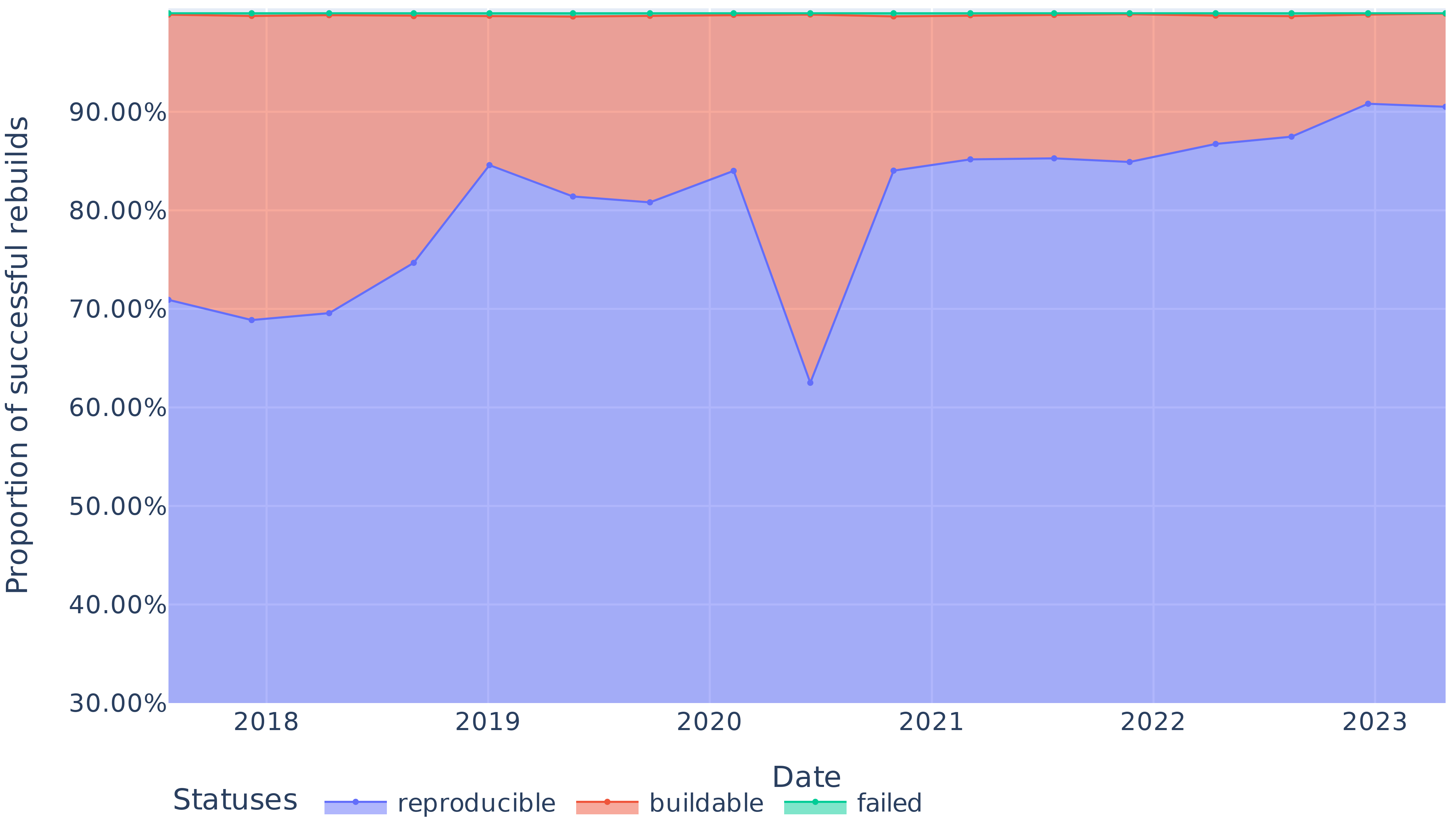{.r-stretch fig-align="center"}
Proportion of reproducible, rebuildable and non-rebuildable packages over time.
:::
## RQ1: Evolution of bitwise reproducible packages
::: {#fig-overall2}
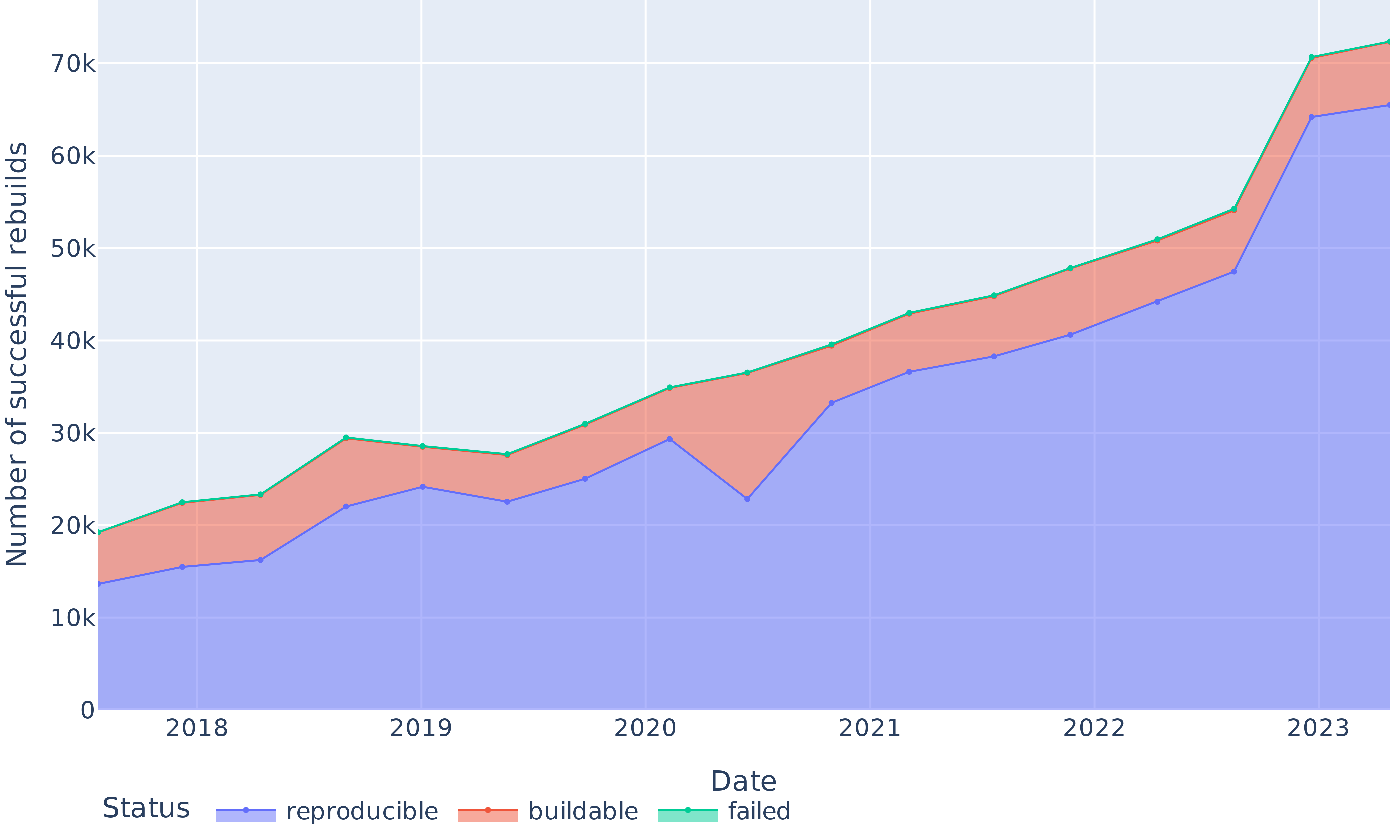{.r-stretch fig-align="center"}
Absolute numbers of reproducible, rebuildable and non-rebuildable packages over time.
:::
## RQ1: Evolution of bitwise reproducible packages
::: {#fig-overall2-reg}
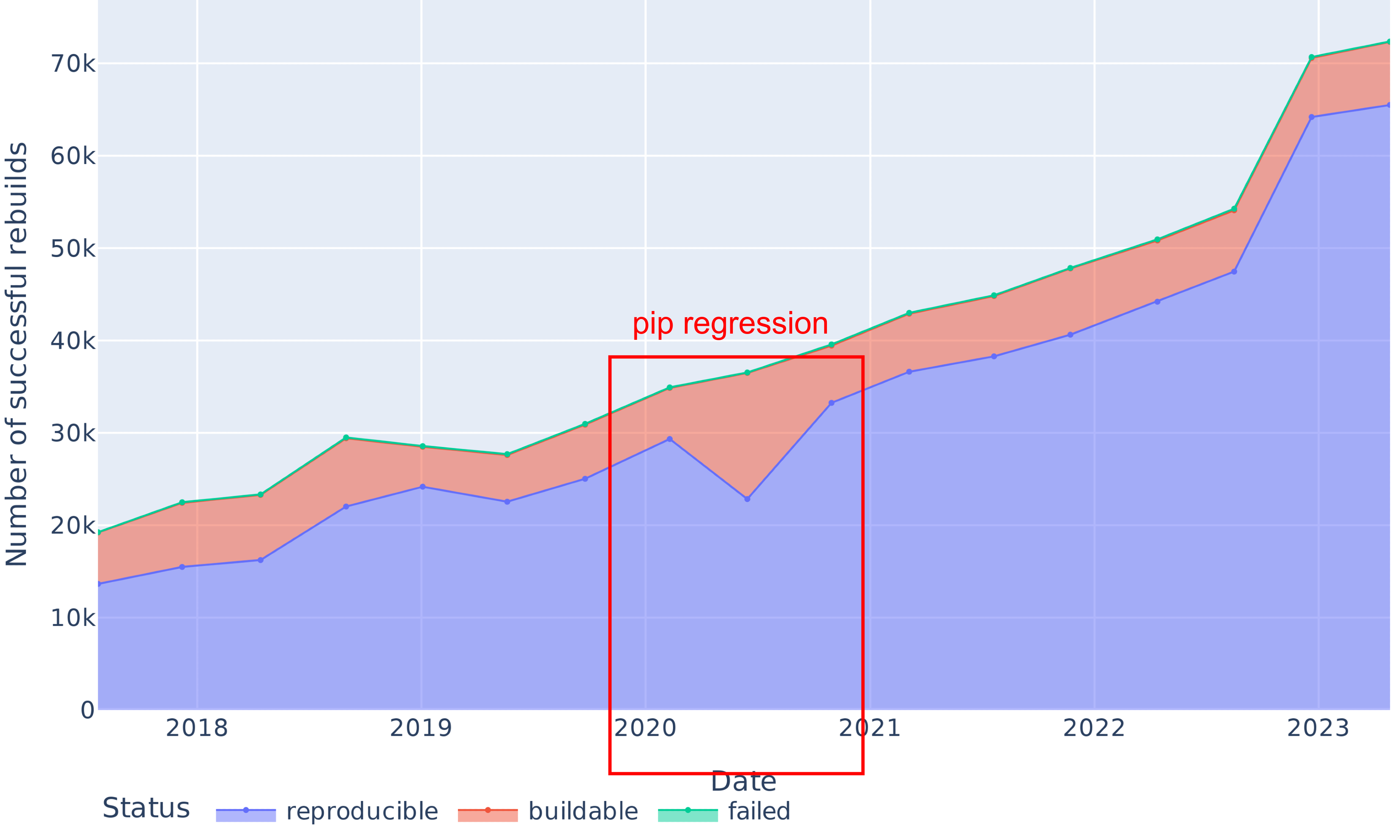{.r-stretch fig-align="center"}
Reproducibility regression around June 2020.
:::
## RQ2: What are the unreproducible packages?
::: {#fig-diff}
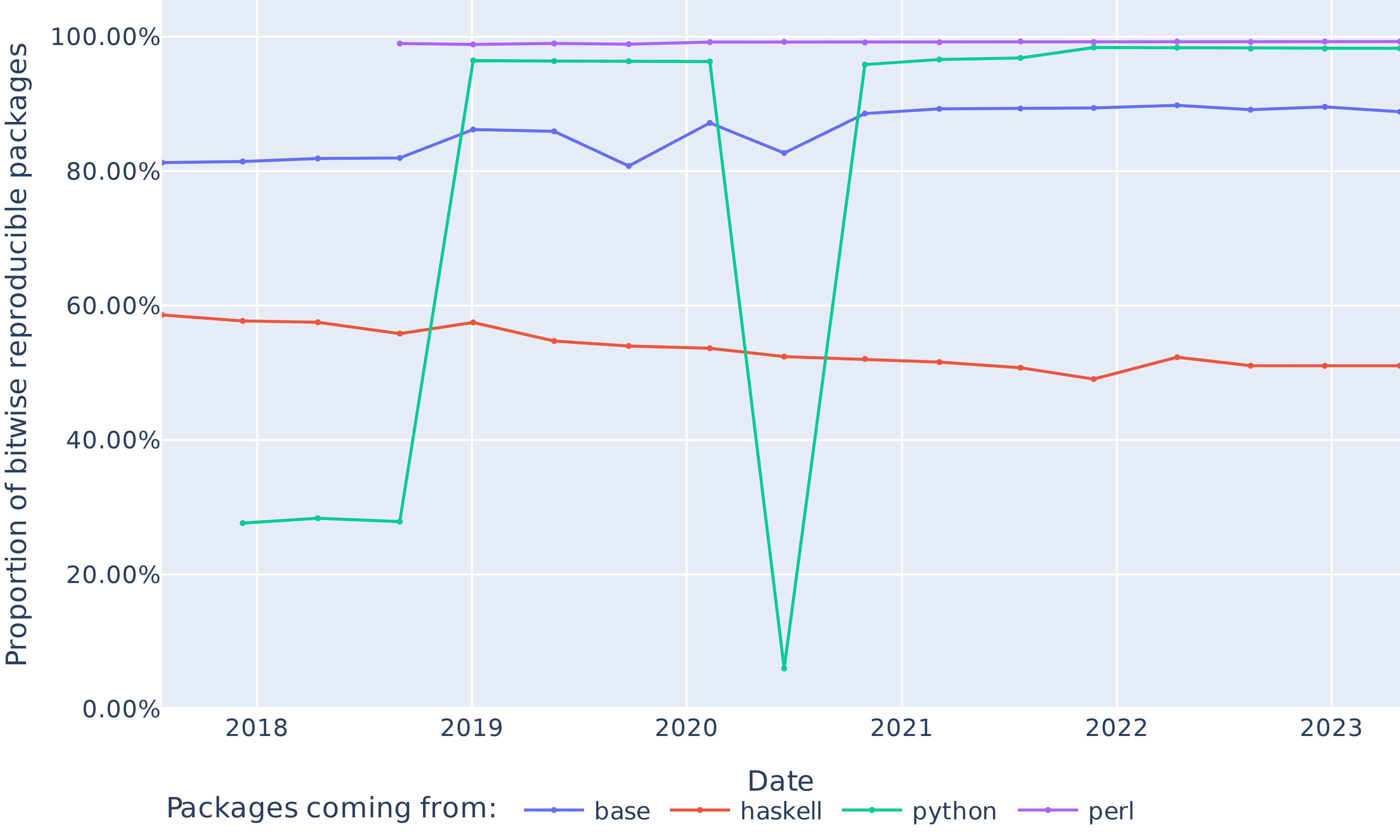{.r-stretch fig-align="center"}
Proportion of reproducible packages belonging to the three most popular ecosystems and the base namespace of nixpkgs.
:::
## RQ3: Why are packages unreproducible?
::: {#fig-diffoscope}

Example of a diffoscope.
:::
## RQ3: Why are packages unreproducible?
::: {#fig-diff}
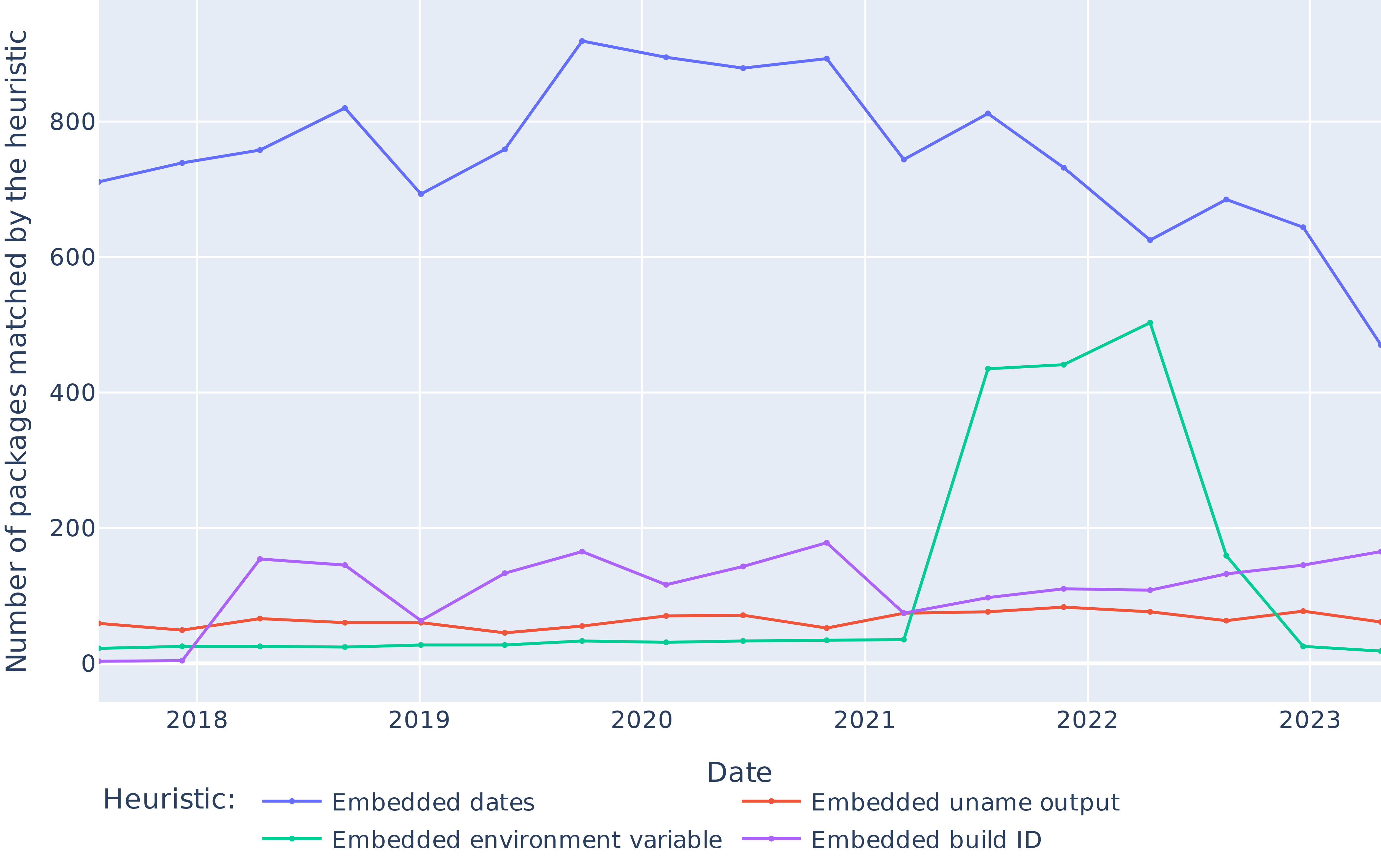{.r-stretch fig-align="center"}
Evolution of the number of packages that are matched by each of our heuristics, over time.
:::
## Conclusion
- Bitwise reproducibility in `nixpkgs` as of 2023: 91%;
- This justifies investing resources/conducting research on distributed cache solutions relying on build reproducibility.
## Thank you for your attention!
My socials:
{{< bi mastodon >}} luj@chaos.social
{{< bi envelope >}} julien.malka@telecom-paris.fr
:::: {.columns}
::: {.column width="50%"}
{height='11em'}
:::
::: {.column width="50%"}
{height='11em'}
:::
::::
## RQ1: Evolution of bitwise reproducible packages
::: {#fig-overall2-reg}
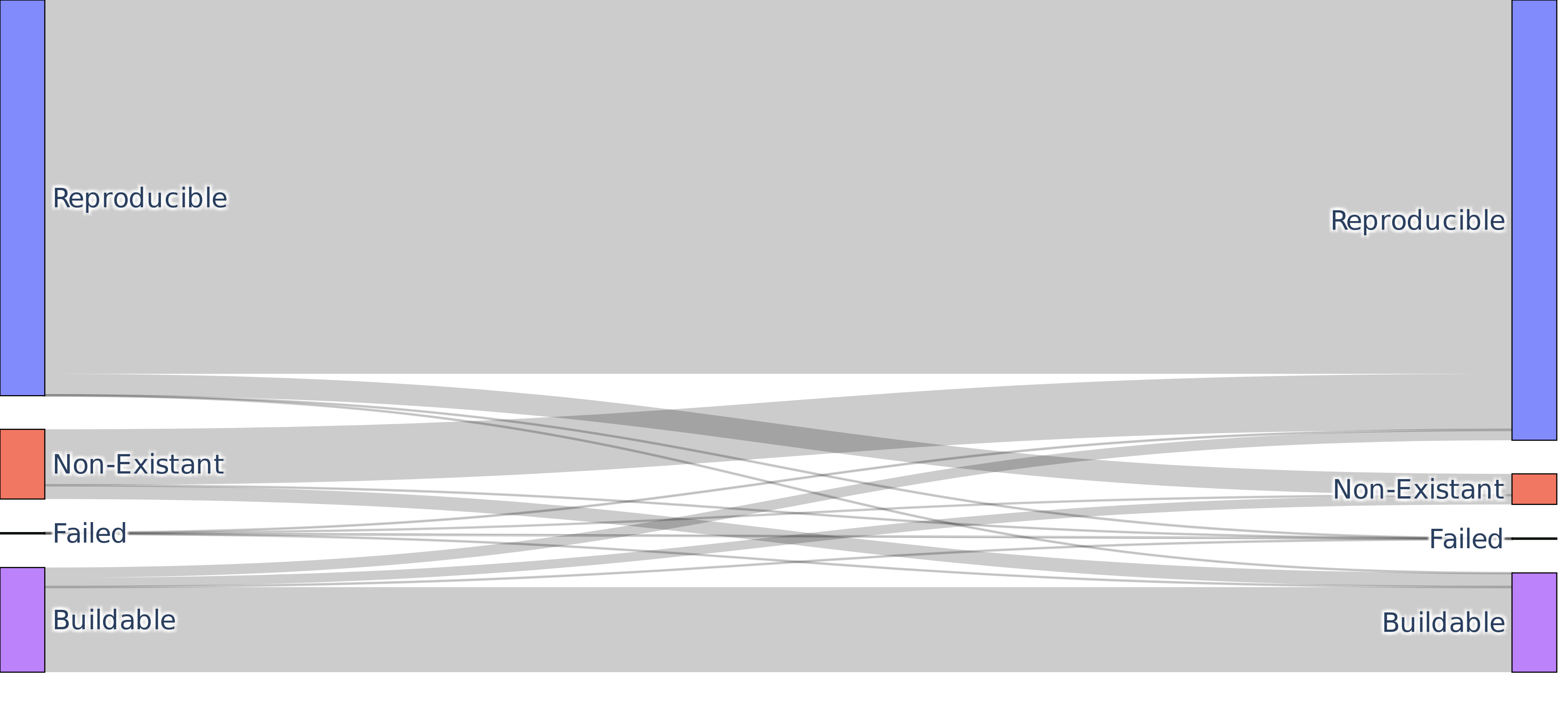{fig-align="center"}
Sankey graph of the average flow of packages between two revisions, excluding the revision from June 2020, considered as an outlier.
:::